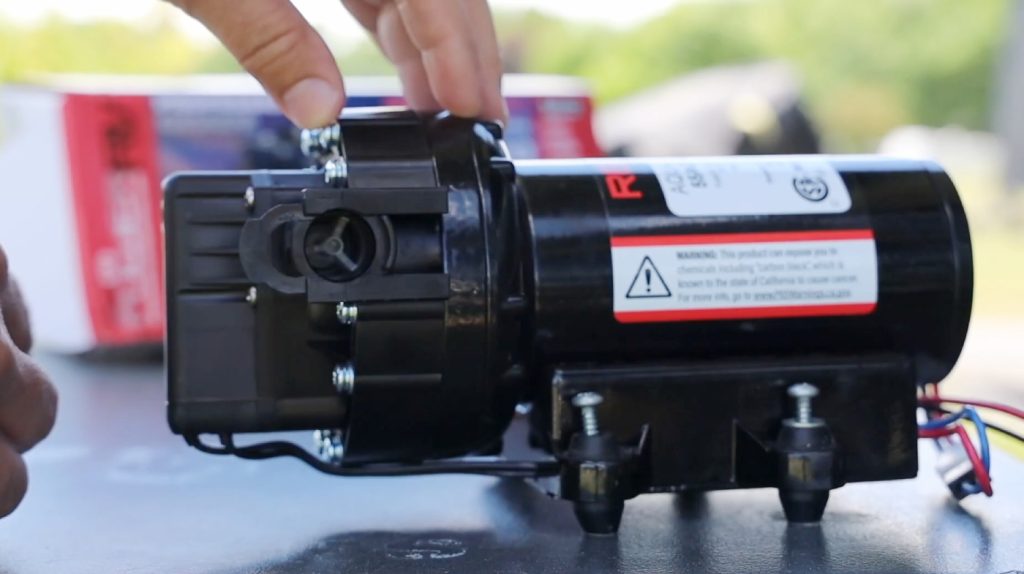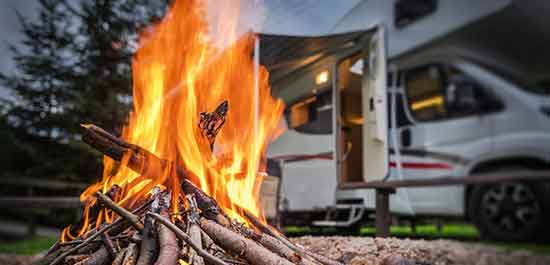Last Updated on February 24, 2025
To prime your RV water pump, first verify the freshwater tank is full and locate the pump. Disconnect the pump from the tank and have someone inside the RV open a faucet. Use warm water to speed up the process.
Check for leaks and make certain connections are tight. Open faucets sequentially to expel air, listening for changes in the pump’s sound to confirm successful priming. If you encounter issues, there are effective troubleshooting steps ahead.
Key Takeaways
- Fill the freshwater tank and ensure the water pump is in good condition before starting the priming process.
- Disconnect the pump from the freshwater tank and use warm water to facilitate faster priming.
- Open a faucet inside the RV to allow an assistant to help expel air from the lines during priming.
- Monitor the pump for changes in noise, indicating successful priming, while checking for leaks in the system.
- Consult the pump’s manual for specific priming instructions and maintenance practices to ensure optimal performance.
Preparation for Priming Your RV Water Pump
Before you start priming your RV water pump, prepare adequately to guarantee a smooth process. First, verify your freshwater tank is filled and ready for use.
Locate the water pump, typically near the freshwater tank, and gather necessary tools like screwdrivers, funnels, and clean hoses. Conduct a thorough inspection of the pump and surrounding system for leaks or damage. Regular maintenance is vital for optimal pump performance, so ensure you follow these checks thoroughly.
Refer to your owner’s manual for specific guidance related to your pump model. Consider using a self-priming pump for easier priming, and confirm it has suitable flow rates and safety features.
Finally, check the system pressure and water temperature; warmer water primes faster due to lower viscosity. These steps set the stage for successful priming.
Steps to Prime the RV Water Pump
To effectively prime your RV water pump, start with proper preparation to guarantee a smooth process. Identifying the Need to Prime the Water Pump is essential, as it ensures that your pump operates efficiently when needed.
You’ll also need to troubleshoot any common issues that might arise during priming, such as trapped air or leaks. Following these steps will help restore water flow and maintain your RV’s plumbing system.
Preparation for Priming
Proper preparation is essential for successfully priming your RV water pump. First, locate the pump, typically near the fresh water tank; check your owner’s manual for a diagram. Clear any obstructions for easy access.
Verify the pump model to guarantee compatibility with your procedures. Gather necessary materials: a clean hose, funnel, screwdriver, and water supply. Additionally, diagnose pump issues before starting the priming process to ensure efficient troubleshooting.
Disconnect the pump from the fresh water tank and make certain the water supply line is ready for reconnection. Position an assistant inside the RV to operate a faucet.
Inspect all pipes and fittings for leaks, and sanitize your equipment to prevent contamination. This careful preparation will streamline the priming process and help avoid complications.
Troubleshooting Common Issues
While troubleshooting common issues with your RV water pump, it’s important to follow a systematic approach to identify and resolve problems effectively.
Start by verifying your fresh water tank is full and all faucets are off. If water isn’t flowing, check for air in the lines or leaks in the fittings. Open one faucet at a time to release trapped air and maintain pressure. Regular maintenance can help prevent pump cycling issues that may disrupt water flow.
Inspect the intake line for blockages and verify the pump’s performance. Confirm all valves are fully open and the pump receives power. If the flow rate is low, confirm that too many faucets aren’t open simultaneously.
Common Issues Encountered During Priming
When priming your RV water pump, several common issues can arise, potentially hindering its performance. Trapped air in the water hose or pump chamber often disrupts efficient operation. Clogged water lines can block the flow, leading to inadequate pressure.
Additionally, leaks in the system, whether along the water lines or at connections, can result in water loss that prevents proper priming. Low water levels in your freshwater tank are also a primary culprit.
Air leaks are common causes for failure to prime; check for cracks in pre-filter bowls or loose fittings. Faulty valves, especially broken shut-off valves, can impede water flow. If the pump hums but doesn’t pump, it may indicate a faulty motor or other internal issues.
Factors Influencing Priming Duration
Understanding the factors that influence priming duration can greatly enhance the efficiency of your RV water pump.
First, consider the pump model; self-priming pumps typically prime faster than non-self-priming ones. The flow rate and pump size also matter—higher GPM and larger pumps generally lead to quicker priming.
Additionally, a quiet water pump can improve the overall experience by reducing noise during operation. Self-priming pumps excel in speed, while higher GPM and larger sizes further enhance priming efficiency.
Pay attention to your water lines; shorter lengths and larger diameters improve flow. Environmental factors like water temperature and altitude can affect priming, too.
Confirm proper system preparation by checking valves and maintaining an adequate water level. Finally, following manufacturer guidelines and using the right tools will streamline the process.
Safety Tips and Maintenance Practices
Before starting any maintenance on your RV water pump, make sure to turn off all power and verify the electrical system with a volt meter. Regular maintenance is essential, so follow a checklist that includes checking for leaks, inspecting filters, and ensuring all connections are secure.
Prioritizing safety and routine checks will help maintain your pump’s efficiency and longevity. Additionally, keep in mind that an RV water pump operates as a motorized diaphragm pump, which is crucial for delivering water from the fresh water tank to various fixtures.
Essential Safety Precautions
Guaranteeing safety during the priming of your RV water pump is essential for preventing accidents and maintaining the system’s integrity.
Start by thoroughly reading your owner’s manual to understand all safety instructions. Always wear protective gear to avoid injuries. Before handling the pump, confirm the power supply is turned off, and guarantee the pump is properly installed to prevent overheating.
A well-maintained water pump ensures reliable water access, especially when the city supply is unavailable, so don’t neglect proper maintenance as part of your routine.
During priming, open a cold water faucet to eliminate air from the system and only activate the pump when ready to use. Check hoses for blockages or leaks, and use warm water for better priming efficiency. Finally, keep a fire extinguisher nearby to address any potential leaks or emergencies promptly.
Regular Maintenance Checklist
Regular maintenance of your RV water pump is essential for its longevity and ideal performance. By following a systematic checklist, you can guarantee your pump operates effectively. Here are key practices to include:
- Inspect strainers regularly to prevent clogging.
- Sanitize the system using bleach for clean water.
- Winterize the system by draining and adding antifreeze before cold weather.
- Check for leaks around joints and valves frequently.
- Monitor pump performance for any unusual noises or changes. Additionally, maintaining water pressure ensures efficient operation when faucets are opened. Regular inspections can catch issues early, extending the operational life of the pump.
Troubleshooting Common Pump Problems
When you encounter issues with your RV water pump, identifying the root cause is essential for effective troubleshooting.
Start by checking for a lack of water in the tank; an empty tank will prevent the pump from functioning. Next, inspect electrical connections for blown fuses or voltage issues.
Additionally, ensure that the pump operates by creating pressure to move water from the potable water tank to fixtures. Verify that all water lines are clear of clogs and securely connected, as leaks or loose connections can lead to pressure loss.
If your pump runs continuously, a leak might be present, or air could be in the lines. Check the water tank first; an empty tank stops the pump. Then, inspect electrical connections for blown fuses or voltage problems.
Additionally, inspect for mineral buildup and verify proper winterization to avoid dried-out components. If problems persist, you may need to replace or consult a technician for further assistance.
Tips for Efficient Priming
To achieve efficient priming of your RV water pump, it’s crucial to understand the system’s mechanics and the role of water flow. Here are some tips to streamline the process:
- Check for leaks: Make sure all connections are secure to prevent water loss.
- Use warm water: It flows better, making priming quicker. Additionally, ensure that the pump is properly primed after running out of water in the fresh tank.
- Open faucets sequentially: This helps to expel air from the lines efficiently.
- Monitor pump sounds: Changes in noise can signal successful priming.
- Refer to the manual: Each pump model has specific requirements that can optimize your efforts.
Frequently Asked Questions
Can I Use Saltwater to Prime My RV Water Pump?
No, you shouldn’t use saltwater to prime your RV water pump. Saltwater can lead to corrosion of metal components, clog filters, and damage the pump due to mineral buildup.
It also compromises the safety of your water supply, making it unsuitable for drinking or washing. Always opt for fresh potable water, as it preserves the integrity of your RV’s water system and extends the lifespan of your pump and other components.
How Often Should I Prime My RV Water Pump?
Think of your RV water pump as a heartbeat—strong and steady. You should prime it whenever you notice signs of air, like low pressure or strange noises. After maintenance or winterization, it’s essential too.
If the pump sits unused for a while, give it a prime to clear out any air. Regular checks can help you gauge when it’s time, ensuring your water flow stays smooth and uninterrupted.
Is Priming Necessary After Winter Storage?
Yes, priming is necessary after winter storage. It guarantees the RV water pump is free from trapped air and antifreeze residue, allowing for proper operation. Without priming, you risk low water pressure or pump failure due to air in the lines.
Additionally, checking for leaks during the priming process helps maintain system integrity. Regular priming after winterization is essential for your pump’s performance and longevity, so don’t skip this important step.
What Tools Do I Need for Priming?
Imagine you’re a conductor preparing an orchestra before a grand performance. To guarantee everything flows smoothly, you’ll need specific tools. For priming, grab a clean hose, a funnel, and a screwdriver. Don’t forget your owner’s manual for guidance.
If managing air, include a pressure gauge and a prime valve if available. Finally, for safety, have sealing tape and a detachable filter on hand. These tools are your instruments for a flawless setup!
Can I Prime the Pump Without a Water Source?
You can attempt to prime the RV pump without an external water source, but it’s challenging. Most pumps are self-priming, yet trapped air in the lines can hinder the process.
If your water tank‘s full, use it as a source. Alternatively, you could manually pour water into the system using a bucket and hose. Be cautious; doing so increases the risk of leaks or pump damage if not executed properly.
Mastering the Art of RV Water Pump Priming
In conclusion, successfully starting your RV water pump involves preparation, patience, and practice. By following the steps outlined and addressing common challenges, you’ll guarantee smooth sailing and steady streams. Don’t forget to prioritize safety and maintenance to prevent future frustrations.
With these techniques and tips, you’ll master the mechanics of priming, keeping your water flowing freely and efficiently. Stay vigilant, and your RV adventures will be filled with revitalizing reliability.



